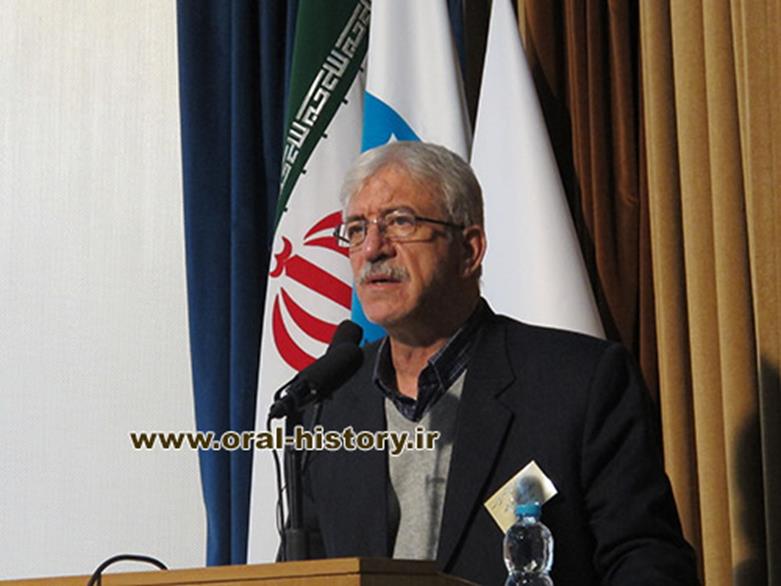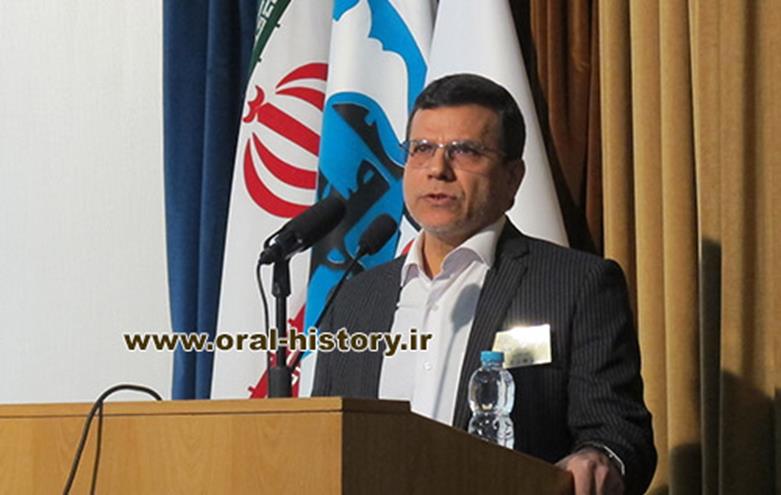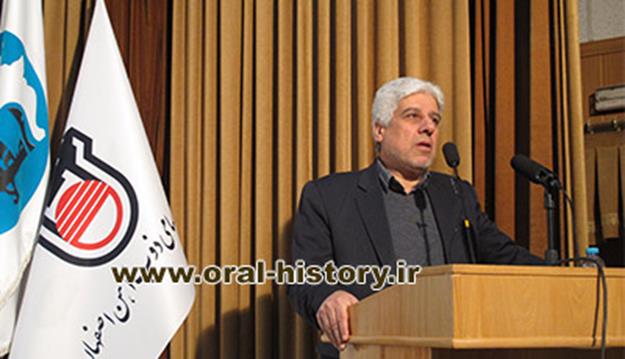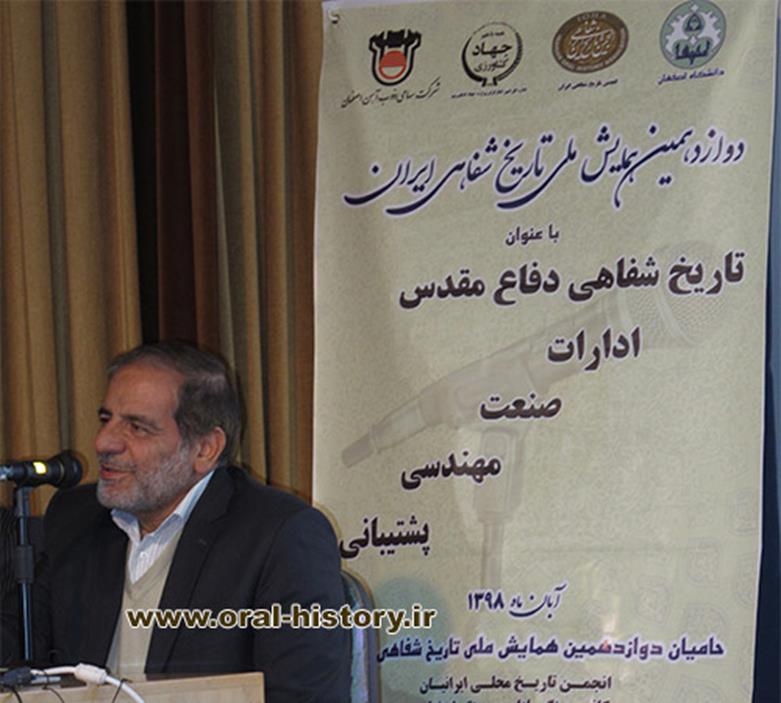Report of “the 12th National Conference of Iranian Oral History”-Part 1
Logistic Forces: Absentees of Sacred Defense Studies
Maryam Asadi Jafari
Translated by Ruhollah Golmoradi
2020-1-1
Dr. Morteza Nouraei, scientific secretary at the 12th Iranian Oral History Conference stated, "What is important to us at this meeting is available archives in departments and stagnant and intact archives of the sacred defense in field of war logistic. The one who defended in the front line needed 99 supporters, and those 99 people were our absentees from our studies of oral history of Sacred Defense. We thought we would face a bunch of technical and rich articles, but we realized that number of researchers who involved in this field was not as widely we expected. So we decided to have two more meetings under the same title until 1400 (2021) in order to organize more research."

According to Iranian Oral History Website, "The 12th National Conference of Iranian Oral History", aimed at "explaining relation and necessity, recognizing role and recovering oral history priorities in field of Jahad-e Sazandegi, Industry, engineering, and logistic in Sacred Defense", was held by Iranian Oral History Association, University of Isfahan, Department of Veteran Affairs of Ministry of Agriculture Jihad, and Isfahan Steel Company in Saeb Hall of Faculty of Literature and Humanities of Isfahan University on December 18, 2019.
Jahad-e Sazandegi; The Third Side of Effective Elements in Holy Defense
Mohsen Kazemi, secretary of Oral History Association said at the beginning of the conference, "Today is a very good day. Because we are standing on the 12th step of the oral history conference. The first, second and third steps have been taken here and today, we have returned to the university house again, and it is valuable that we have done this since 2004 continuously, and we hope continue this path with your active involvement in fields of oral historiography, and to assist cultivating culture of this country. I also thank the four organizers of this conference, University of Isfahan, Oral History Association, Ministry of Agriculture Jihad’s Department of Veterans Affairs and Isfahan Steel Company.”

Then “Dr. Ali Akbar Kajbaf,” secretary of the 12th Iranian Oral History Conference, made a speech about process of design and implementation of the conference, saying that: "This conference is decorated with week of research and a day of unity between seminary and university. We hope we have taken a step towards producing science and knowledge in line with the University's research missions. The conference was held by a series of oral history meetings over the past 15 years and University of Isfahan is proud to be initiator of oral history sessions in universities around the country and as designer of oral history can reflect its necessity in field of oral history. We held this conference in honor of sacrifice of the warriors, jihadists, martyrs and all other factors that support the sacred defense, and we hope we can discharge them in their high presence. To record sacred defense events in area of logistic, industry, and engineering during the sacred defense, we held such conference to commemorate experiences of guys of this country for future generations, and to provide enthusiasts and researchers in field of oral history with information and data. The History Department of University of Isfahan, helped by Oral History Association, Department of Agriculture Jihad, Isfahan Steel Company, and other sponsors, has made a double effort to manage this scientific scene over the past year and a half. Engineering, alongside Artesh and IRGC, was the third side of triangle of effective elements in the war, which is essential to study this subject for progress in field of industry and economics. Jihad work is an interconnected system, composed of a set of value, cultural, and developmental criteria. At this conference, we seek to obtain views and attitudes of authorities and managers, professors and researchers at various levels, based on methodology of oral history research. Other twelve sponsors, such as Isfahan’s Hozeh Honari and Isfahan Sangarsazan-e Bi-sangar (trenchless trench makers) Center, were concerned about oral history and helped us in organizing the 12th Iranian Oral History Conference. Concerning qualitative and quantitative part of the conference, I should say that previous conferences were held either as short, regional, and provincial conferences or in form of a workshop, session or national conference such as today. We did not seek to accept all 120 abstracts which were send to the conference. We selected only articles that were in line with oral history of industry, engineering, and logistic of the war; although more may be published in the symposium and be available to those interested. But we want this conference to be a specialized one, and as University of Isfahan has been a pioneer in this field, it will continue and operate the path in coming years."

Logistic forces; absentees of the sacred defense oral history studies
Then, Dr. Morteza Nouraei, scientific secretary at the 12th Iranian Oral History Conference, welcomed the audience and stated: “surely various sessions and pre-sessions have been taken place, whether in Isfahan or in Tehran with different institutions and organizations so that led to this session where we are today. From our abstracts and articles, there were 30 approved articles that we selected 12 to present in form of three panels that will be held. We constantly monitor what matters and where the need lies. What is important to us about this session is available archives in departments and stagnant and intact archives of the sacred defense in area of the war logistic. The one who defended in the front line needed 99 supporters, and those 99 people were absent from our oral history defense studies. So this topic was discussed at the conference, and existing research showed us that there has been less work in this area. We thought we would face a bunch of technical and rich articles, but we realized that number of scholars involved in this field was not as widely we expected. So both Oral History Association and History Department of University of Isfahan decided to hold two more sessions until 1400 (2021) to organize further research. Our goals at these sessions are to provide research opportunities and identify missing worlds in field of oral history in general, and in strategic areas in particular. We are sure that after this meeting, many books and writings will be produced in this area. This has been our basic solution for many years, but there are also making opportunity, inventiveness and entrepreneurship for history students or interested scholars. The second goal is that in discussing method we have found that what is released as oral history products and produced by various institutions and universities nationwide are, in terms of method, oral memories not oral history. Oral history must be documented. So they did a series of interviews, and since oral history is a brand, they labeled oral history title on it and released it. That's good, but our review showed that more than 70 percent of the products which are released today in the name of oral history are not oral history at all; there are oral interview. So in the discussion of method, we usually have given explanations at such sessions. Highlighting necessities is our other goal, and the other point is that Iranian Oral History Association has a duty to see at what stage is it in international level? At what level is it in terms of theoretical function? This review has been continuously and in exchange with science centers, and I assure you that Iran is the only country in Middle East and much of Asia which is engaged in oral history. Basically Iranian culture is an oral culture and this oral culture has been able to recover and recreate itself in oral history. Once again I point out that our offices are full of Sacred Defense documents that have provided mechanisms to support it (Sacred Defense). We have little information about these institutions and their activities. I need to thank Oral History Association and University of Isfahan for being able to direct this wave of oral history in Iran.”

“Dr. Hooshang Talebi Habibabadi,” president of University of Isfahan, also said in a short speech: "I believe that any history should be documented and what is more important than history of the sacred defense and the issues that have occurred during it; including discussion of sacred defense industry and engineering that I hope this conference will be effective in recording it. If we take a look at role of university before victory of the revolution and afterwards, and believe that history is made by history makers, we can better explain role of university. Its first steps occurred in 1978 and 1979, and university played a prominent role in shaping the revolution and its success. Thereafter, necessities emerged so that academics to be on the scene to preserve and protect achievements of the revolution and there were effective in the sacred defense too. It is necessary to explain role of university documental so that position of university in different areas of the country during Islamic Revolution and the holy defense to be cleared really. There is no doubt that human resource is the first word in any phenomenon, and it is university that enhances human resources. So there is room to explain role of university in different contexts. More than ever, I ask the oral history association to work on this issue and to address role of the university in different contexts at future conferences.”
***
"Dr. Ali Akbar Kajbaf" and "Dr. Morteza Nouraei" were present in the first panel as board of directors, and "Dr. Javad Esteki,” Commander of Seyyed al-Shohada Superior Headquarters in Isfahan, Yazd and Chaharmahal va Bakhtiari Provinces, made a speech on "Oral History of Holy Defense of Operational Areas and Northwest Fronts (West Azerbaijan and Kurdistan): Popular Support" and added, "Over the past 200 years, we have lost about one million square kilometers of our country due to imprudence, inadequacy and weakness of governments, and the most recently was Bahrain during taghut regime of Pahlavi that it was separated from our country. But during the sacred defense period, more than 200,000 martyrs prevented one meter of our country to be captured. Our people and nation resist, defend, give martyr, veteran and prisoner, but not surrender to the enemy, and we enter the second step of the revolution in 2019. When the revolution succeeded, the enemy said that we should destroy it before the revolution to be formed. According to them, there was a political earthquake in the world by Hazrat Imam Khomeini (PBUH) and Iranian people that shocked everywhere. So they planned and implemented various projects that one of which was separation of the country.”

He further described up and downs of struggles in Kurdistan region in before and after the beginning of the war and talked about capabilities of oral history in field of “human support of warriors" in three areas of "dispatch of volunteers of IRGC, Artesh and NAJA organizationally, dispatch of popular volunteers of warriors and dispatch of women”, “Jahad-e Sazandegi measures in two areas of volunteer forces with different specialties, machinery and equipment and Construction (Sazandegi)”and “public institutions by Friday and congregation Imams, people and family of martyrs and Jahad-e Sazandegi.”
Engineer Morteza Shirinparvar, Director of Development and Research at Isfahan Steel Company, also described its role in field of human resources, technical-engineering services and equipment during 8 years of Holy Defense: "By forming union of Islamic Associations in Isfahan Steel Company, aimed at shaping, preserving and protecting achievements of the revolution, the company began dispatch troops to the front, pursuing and coordinating in conducting and presenting financial-supportive and technical services to the front line and rear. At that time, there was virtually no research work done on constructing war equipment and needs of the front, but with strength and expertise of Isfahan Steel Company, our colleagues made measures at the time in central laboratory of the company regarding required analysis and technical designs including tank cover, 120mm and 150mm artillery and so on. Because of our technical capability we had in manufacturing and operation workshops, we were able to produce all needed items of the front, and we had effective technical activities to the front and rear. Manufacturing concrete bunkers in war headquarters, organizations and IRGC, producing 56mm bars for mortar bullets and barbed wire is just one part of Isfahan Steel Company services during the war. More than 21,000 people were trained in Isfahan Steel Company. We had 286 dear martyrs, 86 liberated (Azadeh) and 1,400 veterans during the imposed war. There are currently 414 fighters, 516 martyr’s children and 1005 veterans working in the company. In the end, we wish the highest status to the 286 high martyrs of the company.”
At the end of the first part of the twelfth Iranian Oral History Conference, “Dr. Abdollah Fatehi”, an activist in field of veteran affairs of Agriculture Jihad, described founding history of Jahad-e Sazandegi after victory of the revolution.
"The 12th National Conference of Iranian Oral History", aimed at "explaining relation and necessity, recognizing role and recovering oral history priorities in field of Jahad-e Sazandegi, Industry, engineering, and logistic in Sacred Defense", was held by Iranian Oral History Association, University of Isfahan, Department of Veteran Affairs of Ministry of Agriculture Jihad, and Isfahan Steel Company in Saeb Hall of Faculty of Literature and Humanities of Isfahan University on December 18, 2019.
Number of Visits: 3571








The latest
Most visited
How to send Imam's announcements to Iran
In the first part, the issue of funds, Hajj Sheikh Nasrallah Khalkhali - who represented most of the religious authorities - was also the representative of Imam. In Najaf, there was a money exchange office that cooperated with the money exchange offices in Tehran. Some of the funds were exchanged through him.Operation Beit al-Moqaddas and Liberation of Khorramshahr
After Operation Fat’h al-Mobin, we traveled to Kermanshah and visited Sar-e-Pol-e-Zahab before heading to Ilam. During Operation Beit al-Moqaddas, the 27th Brigade was still receiving support from the West. We maintained contact with individuals who had previously worked in Area 7 and were now leading the brigade. It was through these connections that I learned about Operation Beit al-Moqaddas.Memoirs of Hujjat al-Islam Reza Motalebi
Hujjat al-Islam Reza Motalebi is a cleric from Isfahan. Before the revolution, he was the imam of the Fallah Mosque – which was later renamed Abuzar Mosque. By his presence and efforts, Abuzar Mosque soon became a base for supporters of the Imam and the revolution. After the victory of the revolution, he played a role in uniting forces and maintaining political vitality in southwest Tehran.The Necessity of Receiving Feedback in Oral History
Whenever we engage in a task, we naturally seek ways to evaluate our performance — to correct shortcomings and enhance strengths. Such refinement is only possible through the feedback we receive from others. Consider, for instance, a basketball player whose shots are consistently accurate; should he begin shooting blindfolded, his success rate would rapidly decline, as he would be deprived of essential feedback from each attempt.

